The global pressure washer market size accounted for USD 2.10 billion in 2024, grew to USD 2.18 billion in 2025 and is expected to be worth around USD 3 billion by 2034, expanding at a CAGR of 3.61% between 2024 and 2034. The North America pressure washer market size is calculated at USD 900 million in 2024 and is estimated to grow at a CAGR of 3.79% during the forecast period.
The global pressure washer market size is calculated at USD 2.10 billion in 2024 and is projected to surpass around USD 3 billion by 2034, with a CAGR of 3.61% from 2024 to 2034. The demand from industrial, residential, and other commercial areas for cleaning with lower maintenance costs and time is driving the growth of the pressure washer market.
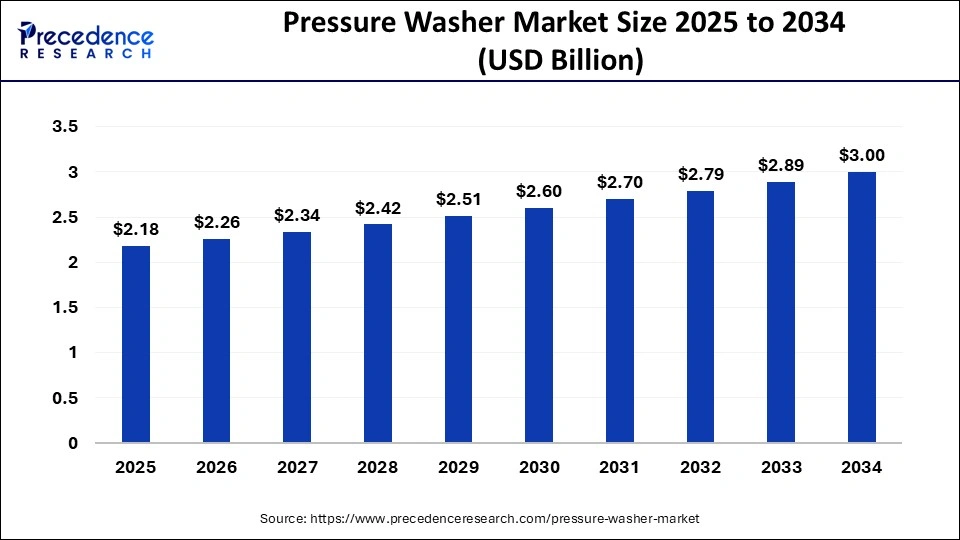
The U.S. pressure washer market size is evaluated at USD 390 million in 2024 and is projected to be worth around USD 570 million by 2034, growing at a CAGR of 3.75% from 2024 to 2034.
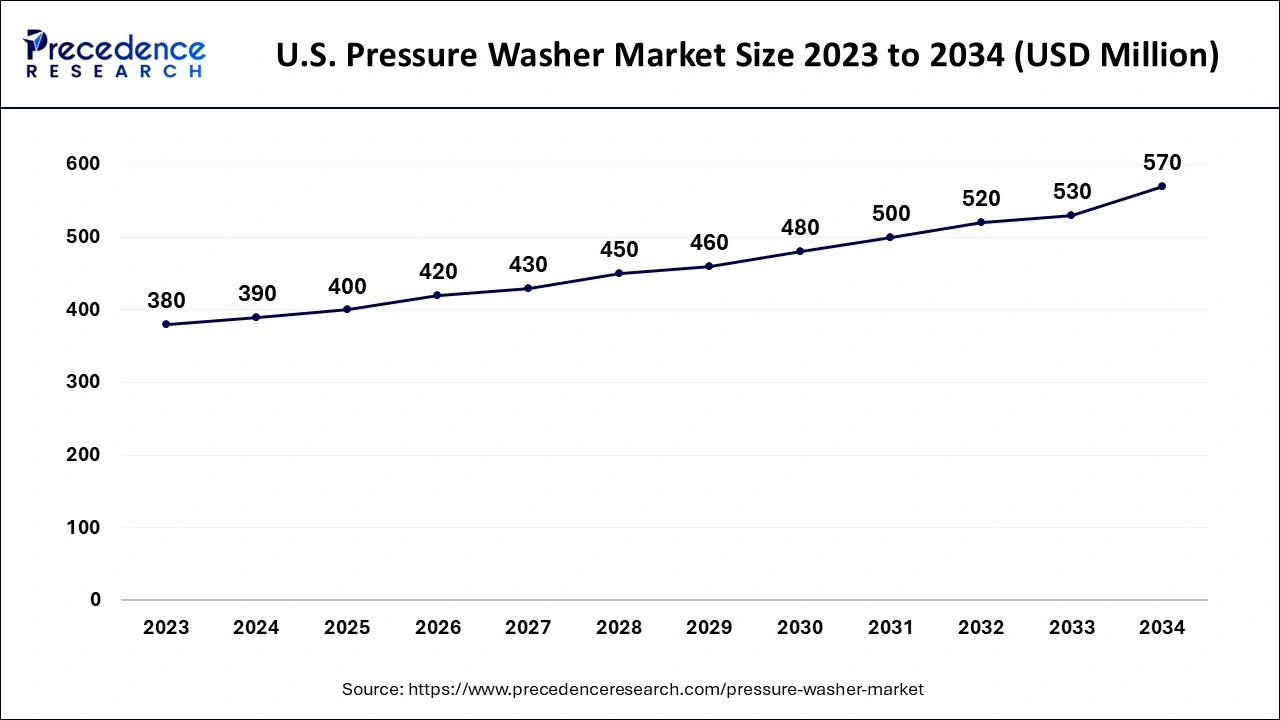
North America dominated the pressure washer market in 2023. The region has the highest consumer of pressure washers due to rising industrialization, and the disposable income in the population increases the number of automobiles, which tends to grow in car washing centers. The increasing demand for pressure washers from industries, car washing centers, households, commercial buildings, and others to maintain cleaning and hygiene with lower time and cost is driving the growth of the pressure washer market in the region.
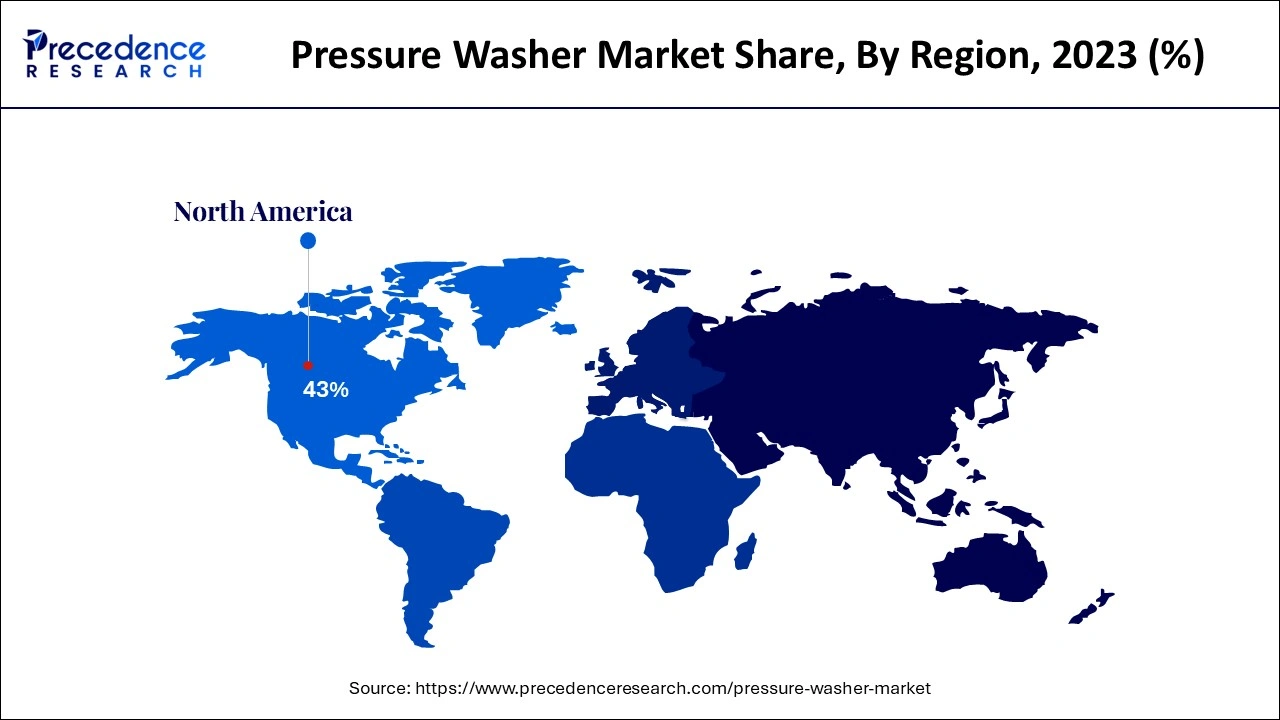
Asia Pacific is estimated to show the fastest growth during the forecast period. The growth of the market in the region is increasing due to the rising population, and disposable income is driving the demand for technologically advanced consumer electronics like vacuum cleaners, washing machines, pressure washers, and others for an easy lifestyle. The higher demand for pressure washers from hospitals, corporate offices, schools, public gardens, and others boosts the growth of the pressure washer market across the region.
The pressure washer is also known as power washing equipment. The pressure washer is used to clean dirt, mud, paint, mold, grime, and other dirty surfaces with high-pressure water spray. The pressure can be measured by Pascal’s per square inch or bars. All these measures can be applied to the pump and adjusted to the unloader valve. The pressure washer produces pressure from 750 to 30,000 psi (5 to 200 MPa), and more depends on the type of the pressure washer. The hot and cold water pressure washers are the two main types of pressure washers that can be used in different settings, including gutters, decks, roofs, sidings, paved areas, windows, and cladding. This type of pressure washer is used for residential, commercial, and industrial cleaning purposes.
There are some of the best pressure washers are available in the 2024 market
How Can AI Impact the Pressure Washer Market?
Artificial Intelligence (AI) can benefit the pressure washing industry in several ways; it has revolutionized the overall performance and effectiveness of the pressure washer. There are some AI functions, such as automation in the cleaning process, which analyzes the optimal water pressure, surface being cleaned, cleaning pattern, and duration. Additionally, real-time monitoring, predictive maintenance, and other algorithms help in analyzing and detecting the cleaning process. AI helps enhance efficiency, productivity, user safety, experience, and other things.
| Report Coverage | Details |
| Market Size by 2034 | USD 3 Billion |
| Market Size in 2024 | USD 2.10 Billion |
| Market Growth Rate from 2024 to 2034 | CAGR of 3.61% |
| Largest Market | North America |
| Base Year | 2023 |
| Forecast Period | 2024 to 2034 |
| Segments Covered | Product, Application, and Regions |
| Regions Covered | North America, Europe, Asia-Pacific, Latin America and Middle East & Africa |
Rising concern about cleanliness and hygiene
The rising concern about cleanliness and hygiene in the population and the rising cases of infectious chronic diseases due to the lack of hygiene and cleanliness is driving the demand for the pressure washer market. The pressure washer helps clean various settings, including residential, commercial, and industrial. Pressure washing provides efficient cleaning, cost efficiency, time-saving, versatility, and provide healthier living spaces. It has the ability to remove mud and tough stains like oil and grease. Additionally, the rising government initiatives in clean city and clean world initiatives are boosting the growth of the market.
Potential damage
Inexperienced hands-on pressure washing in different applications may cause severe damage, such as damaging the car print in garage usage. Extreme water pressure can damage the components of the cars, which is one of the limiting factors in the pressure washer market.
Advancements in pressure washing
The technological advancements in pressure washer machines, such as the rise in eco-friendly and efficient washing machines with increased performance features, heat assistance pressure washing, sustainability in pressure washing with the evaluation of Water Conservation and Recycling pressure washing, and others are collectively driving the growth opportunities in the pressure washer market expansion.
The electric-based pressure washer segment led the pressure washer market in 2023. The rising demand for electric pressure washers is due to their numerous benefits, such as durability, enhanced power, and use efficiency. Electric-based pressure washers are a more powerful alternative to conventional pressure washers; they are much quieter and emit only about 78 decibels, like any other washing machine.
They emit lower noise pollution and are helpful in places like hospitals, schools, and offices. However, electric-based pressure washers are much lighter in weight because they don't have any fuel or gas tanks attached to them. These are much safer to use, though it does not emit harmful gases to the environment, which makes them safer to use in indoor locations. Electric-based pressure washers are affordable, require less maintenance, and have several other beneficial properties that make them ideal for use.
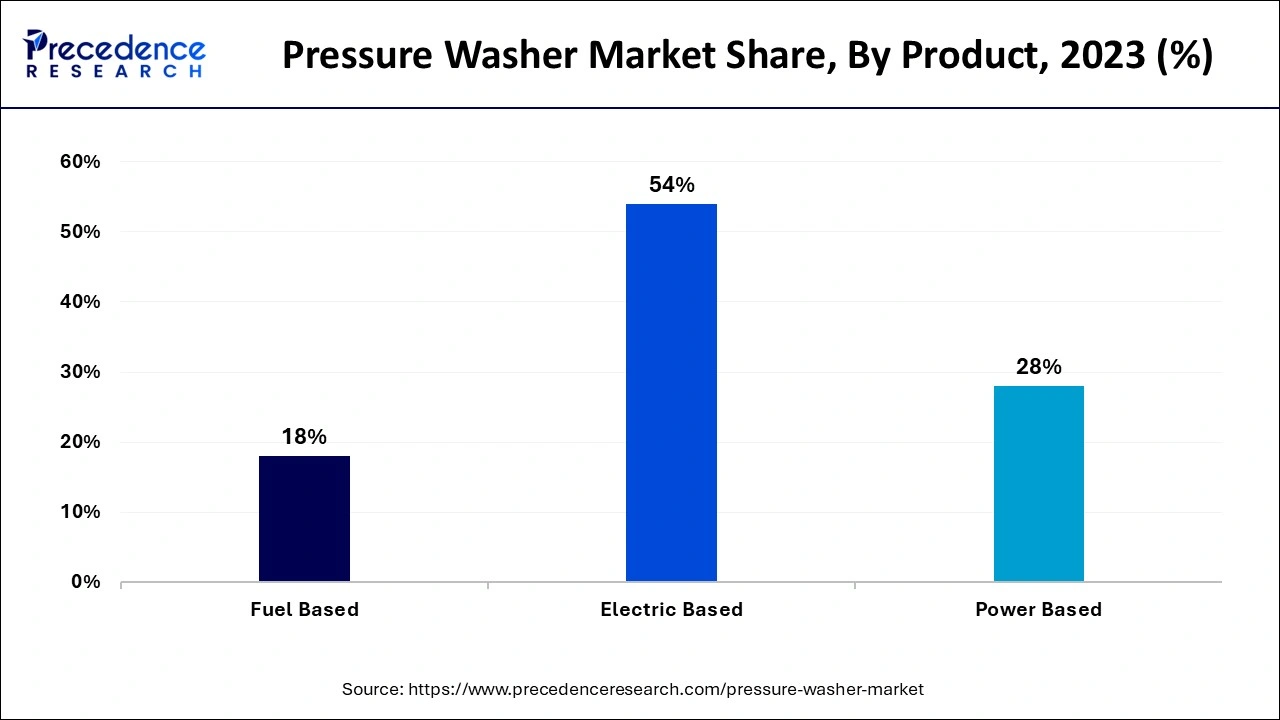
The gas-based pressure washer segment is expected to grow at a significant rate over the studied period of 2023 to 2034. The gas-based pressure washers are used for tough cleaning jobs due to their higher power and pressure capabilities. These types of pressure washers had a higher PSI (pounds per square inch), making them capable of cleaning a year’s long stubborn dirt. The gas-based pressure washers are easy to use and highly affordable.
The garden washer segment dominated the pressure washer market in 2023. The rising adoption of pressure washers in gardening for cleaning purposes in the garden areas is driving the demand for pressure washers. Pressure washers are highly used for cleaning the private garden or the yard of the house, or they are used on public grounds. Cleaning with a pressure washer can save time and money; it takes much less time than any other traditional method of cleaning. The garden areas, such as walking floors and yards, are covered with mud, soil, dirt, and other fungus due to moisture, which requires time to clean and maintain. The pressure washer is the ideal solution for cleaning the garden areas with less time and money and with less water.
The home exterior washer segment is predicted to witness the fastest growth in the market over the forecast period. The pressure washer is the highly adopted equipment or machinery that is used in cleaning the exterior part of the home, such as cleaning the driveway, cleaning exterior walls of the house, sidewalks, brick patios and walkways, garage floor, garage door, cleaning deck, Stripping Paint Using a Pressure Washer, Power Washing a Fence, Power Wash the Roof or Shingles, Cleaning Gutters and Soffits, Cleaning Chairs and Patio Furniture, Lawn Mower Undercarriage, and others.
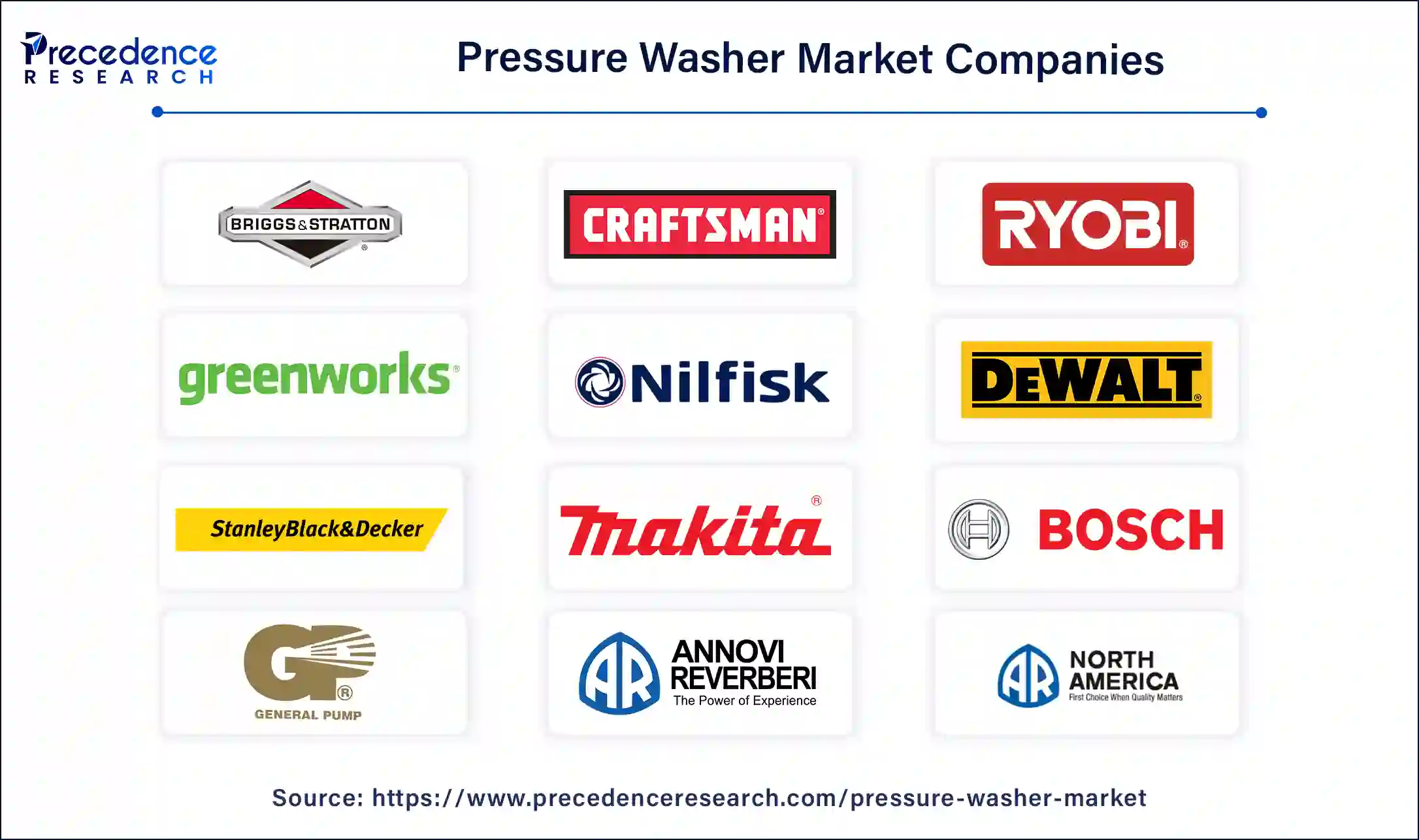
Segments Covered in the Report
By Product
By Application
By Geography
For inquiries regarding discounts, bulk purchases, or customization requests, please contact us at sales@precedenceresearch.com
No cookie-cutter, only authentic analysis – take the 1st step to become a Precedence Research client